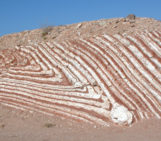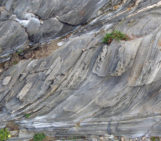
In 2008 Roland Bürgmann and Georg Dresen published their Must-Read paper on the rheology of the lower crust and upper mantle, based on findings from the lab, the field and space. As stated in the introduction, “rheology is the study of the flow and deformation of all forms of matter,” and as such the rheology of the Earth’s lower crust and upper mantle is closely linked to the evolution and deformation of tectonic plates as a whole. This paper is a review paper, neatly summarizing decades of findings on the topic, and conveniently divided into an introduction on end-member rheological models, followed by sections on constitutive laws and formulas, laboratory observations, geodetic observations, field observations and a section reconciling all those findings.
The strength of the paper is really how it draws from all these different fields, which typically operate separately, to point out the observations that divide and reconcile. The early 21st century had given rise to a controversial debate on the strength profile of the lithosphere, tastefully divided into the ‘jelly-sandwich’ (e.g. Burov and Watts, 2006) and ‘crème brulée’ (e.g. Jackson et al., 2008) models. The former implies a relatively weak lower crust located in between a strong upper crust and strong upper mantle, whereas the latter implies a strong upper crust above a weaker lower crust and mantle (Fig. 1). The paper by Burgmann and Dresen (2008) shows how a jelly sandwich profile fits well with several observations of old, thick and cold lithosphere of continental cratons, but that the hotter temperatures and wetter conditions of strongly deforming back-arc crust fits better with a crème brulée type structure. On top of that, with the banana-split model they introduce another food-inspired classification, typical for crustal fault zones that have been weakened, and usually rich in fluids and thus changing the rheological behaviour.

Figure 1: Figure from Burgmann and Dresen (2008), showing a summary of end-member types of lithospheric profiles as discussed within the paper. Differential stress is an indicator of rock strength.
This Must-Read paper presents several lines of future research that would further advance our understanding of lithospheric rheology, again for either laboratory work, fieldwork and/or geodetic observations. Several future studies have indeed built upon the key outcomes presented by Burgmann and Dresen, broadly ranging from similar topics like earthquakes and fault mechanics (e.g. Scholz et al. 2019, Liu et al., 2021) to seemingly further topics like coastal land subsidence (Shirzaei et al. 2021). The term “banana-split model” has been used in many studies since this paper, several of them presenting observations confirming the lateral gradients in rheological properties around fault zones (e.g. Fagereng and Biggs, 2019).
All in all this paper is an excellent starting point for those who aim at understanding how tectonic plates deform, and how their strength may vary depending on the setting; whether you’re focused on labwork, fieldwork, geodetic observations or all of them.
Written by Gino de Gelder and the TS must read team
References
Bürgmann, R., & Dresen, G. (2008). Rheology of the lower crust and upper mantle: Evidence from rock mechanics, geodesy, and field observations. Annu. Rev. Earth Planet. Sci., 36, 531-567. https://doi.org/10.1146/annurev.earth.36.031207.124326
Burov, E. B., & Watts, A. B. (2006). The long-term strength of continental lithosphere:” jelly sandwich” or” crème brûlée”?. GSA today, 16(1), 4.
Fagereng, Å., & Biggs, J. (2019). New perspectives on ‘geological strain rates’ calculated from both naturally deformed and actively deforming rocks. Journal of Structural Geology, 125, 100-110.
Jackson, J., McKenzie, D. A. N., Priestley, K., & Emmerson, B. (2008). New views on the structure and rheology of the lithosphere. Journal of the Geological Society, 165(2), 453-465.
Liu, S., Shen, Z. K., Bürgmann, R., & Jónsson, S. (2021). Thin crème brûlée rheological structure for the Eastern California Shear Zone. Geology, 49(2), 216-221.
Scholz, C. H. (2019). The mechanics of earthquakes and faulting. Cambridge university press.
Shirzaei, M., Freymueller, J., Törnqvist, T. E., Galloway, D. L., Dura, T., & Minderhoud, P. S. (2021). Measuring, modelling and projecting coastal land subsidence. Nature Reviews Earth & Environment, 2(1), 40-58.



